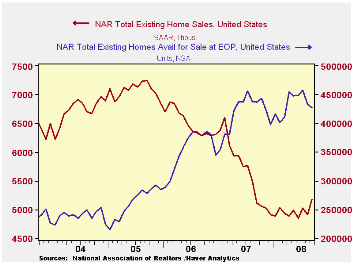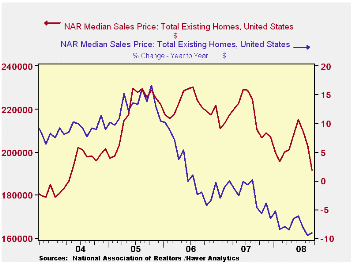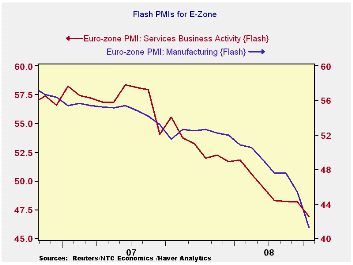 Global| Oct 24 2008
Global| Oct 24 2008Lower Prices Spurred U.S. Existing Home Sales
by:Tom Moeller
|in:Economy in Brief
Summary
The level of September existing homes jumped 5.5% from August to 5.180 million, according to the National Association of Realtors. The rise followed an unrevised 2.2% August decline and beat Consensus expectations for a selling rate [...]

The level of September existing homes jumped 5.5% from August to 5.180 million, according to the National Association of Realtors. The rise followed an unrevised 2.2% August decline and beat Consensus expectations for a selling rate of 4.95M homes. Total sales include sales of condos and co-ops.
Median home prices fell 5.7% (NSA) last month for the third consecutive monthly drop. That pulled the y/y comparison to -9.0%. Prices have fallen 16.7% since their peak in April 2007.
Sales of existing single-family homes rose 6.2% after an
unrevised 1.4% August decline. The y/y gains in both total sales and
sales of single family homes turned positive for the first time since
November 2005. Sales of existing homes, nonetheless, are down by
one-third from their peak in mid-2005.
By region, home sales in the West led last month's increase with a 16.8% m/m gain. That lifted sales by more than one third versus the year ago level. Sales in the Midwest also rose but by a lesser 4.4%; the y/y change is still a negative 2.5%. In the South rose 2.2% (-7.8% y/y) but sales in the Northeast were off 1.2% (-7.7% y/y).
The number of unsold homes (condos & single-family) on the market fell 1.6% during September (-2.4% y/y) after a 5.2% August drop. At the current sales rate, the inventory fell to a 9.9 months supply versus the April peak of 11.2 months. For single-family homes, however, the inventory fell a bit more to a 9.4 months supply at the current sales rate, down from an 11.0 months supply in June.
Subprime Facts: What (We Think) We Know about the Subprime Crisis and What We Don’t from the Federal Reserve Bank of Boston is available here.
| Existing Home Sales (Thous) | September | y/y % | August | September '07 | 2007 | 2006 | 2005 |
|---|---|---|---|---|---|---|---|
| Total | 5,180 | 1.4 | 4,910 | 5,020 | 5,672 | 6,508 | 7,076 |
| Northeast | 840 | -7.7 | 850 | 910 | 1,008 | 1,090 | 1,168 |
| Midwest | 1,190 | -2.5 | 1,140 | 1,220 | 1,331 | 1,491 | 1,589 |
| South | 1,900 | -7.8 | 1,860 | 2,060 | 2,240 | 2,576 | 2,704 |
| West | 1,250 | 34.4 | 1,070 | 930 | 1,093 | 1,353 | 1,617 |
| Single-Family | 4,620 | 3.8 | 4,350 | 4,450 | 4,958 | 5,703 | 6,181 |
| Median Price, Total, $ | 191,600 | -9.0 | 203,100 | 210,500 | 216,617 | 222,000 | 218,217 |
by Robert Brusca October 24, 2008

Europe’s PMIs are now weak. They are at or near the lows we
have seen since the services PMI was issued in July of 1998. Both
service sand MFG PMIs are below their respective neutral readings of 50
and are thus indicating CONTRACTION.
The MFG PMI is even at its lowest level since June of 1997
when its survey began.
The month to month drop in the MFG index is the largest over
this period while the services drop ranks as about the 18th smallest
‘gain’ in its history of the 63 drops in the 123 observation of the
series. This months’ drop also ranks 45 in size among all drops or as
the eighteenth largest drop when ranked among drops (or the bottom 28
percentile). In relative magnitude this month’s service sector drop is
a bottom third affair. The MFG sector is taking the relatively larger
hit for this month. It is taking its largest drop on record and falling
to its lowest position in its history.
Europe has been a late comer to weakness but is catching up
with the US. In September the US MFG PMI stood at a level 43.5, below
where Europe was then but above where Europe is now. The US ISM may yet
fall to a lower level in October and be weaker than Europe. But the two
indices are clearly now sharing the same dimension of weakness
regardless of which is the weaker. Last month the US non-MFG PMI stood
at a level of 50 above the service sector reading for EMU. EMU’s drop
to 46.91 seems clearly a weaker reading than what we get out of the US
Non-MFG PMI (where 44.6 is the weakest reading ever) since sharp
declines have not marked its recent trend. But things are changing fast
and maybe the US non-MFG sector will weaken beyond Europe’s reading. We
do not yet know how rapidly the economy descended in October. But this
is not a time that has rewarded optimistic projecting. Maybe the
message from Europe is that we should brace ourselves for even worse
news from the US.
One message from Europe is nonetheless clear. Both MFG and
Services indices are quite weak and the MFG sector is falling very hard
right now. Expect the more conventional readings for Europe to start to
look a lot weaker. Since this report is topical and up-to-date as of
October it is a month or two ahead of the release of more conventional
economic reports form Europe.
| FLASH Readings | ||
|---|---|---|
| Market PMIs for the E-Zone-13 | ||
| MFG | Services | |
| Oct-08 | 41.33 | 46.91 |
| Sep-08 | 44.97 | 48.44 |
| Aug-08 | 47.55 | 48.46 |
| Jul-08 | 47.38 | 48.32 |
| Averages | ||
| 3-Mo | 46.63 | 47.76 |
| 6-Mo | 48.40 | 48.60 |
| 12-Mo | 50.37 | 50.52 |
| 33-Mo Range | ||
| High | 57.61 | 60.65 |
| Low | 41.33 | 46.68 |
| % Range | 0.0% | 1.6% |
Tom Moeller
AuthorMore in Author Profile »Prior to joining Haver Analytics in 2000, Mr. Moeller worked as the Economist at Chancellor Capital Management from 1985 to 1999. There, he developed comprehensive economic forecasts and interpreted economic data for equity and fixed income portfolio managers. Also at Chancellor, Mr. Moeller worked as an equity analyst and was responsible for researching and rating companies in the economically sensitive automobile and housing industries for investment in Chancellor’s equity portfolio. Prior to joining Chancellor, Mr. Moeller was an Economist at Citibank from 1979 to 1984. He also analyzed pricing behavior in the metals industry for the Council on Wage and Price Stability in Washington, D.C. In 1999, Mr. Moeller received the award for most accurate forecast from the Forecasters' Club of New York. From 1990 to 1992 he was President of the New York Association for Business Economists. Mr. Moeller earned an M.B.A. in Finance from Fordham University, where he graduated in 1987. He holds a Bachelor of Arts in Economics from George Washington University.






